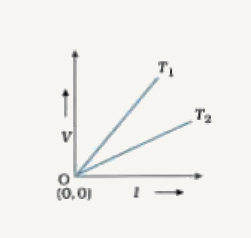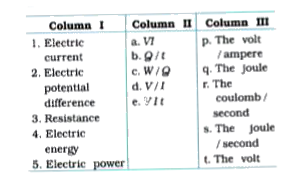1 C = ......... μCSolution in Gujrati
10−6
10−3
1
106
The correct Answer is:D
106
Topper's Solved these Questions
- ELECTRICITYBook:KUMAR PRAKASHANChapter:ELECTRICITYExercise:OBJECTIVE QUESTIONS AND ANSWERS (Answer the following questions as directed (Miscellaneous):)
Explore 53 Videos
- ELECTRICITYBook:KUMAR PRAKASHANChapter:ELECTRICITYExercise:VALUE BASED QUESTIN WITH ANSWERS
Explore 15 Videos
- ELECTRICITYBook:KUMAR PRAKASHANChapter:ELECTRICITYExercise:OBJECTIVE QUESTIONS AND ANSWERS (Match the following:)
Explore 3 Videos
- MAGNETIC EFFECTS OF ELECTRIC CURRENT Book:KUMAR PRAKASHANChapter:MAGNETIC EFFECTS OF ELECTRIC CURRENT Exercise:VALUE BASED QUESTIONS WITH ANSWERS
Explore 15 Videos
Similar Questions
The voltage - current (V-1) graphs for a metallic conductor at two different temperatures T1andT2 are shown below:

At which temperature is the resistance higher?
View SolutionMedha observed that the tubelights in the corridor of her school were always switched on the whole day. She brought the matter to the notice of her class teacher who talked to the Principal about it. The Principal took immediate action.
Medha helped this way to reduce air pollution. Explain how.
View Solution
View SolutionShalini and his brother Amey observed a water-pump working , Shalini inquired how an electric motor works . Amey collected different parts of an electric motor e.g., field - magnets , cabon- brushes , armature , battery , switch, connecting wire , split - rings , etc, and showed them to Shalini . Amey then explained how an armature could rotate.
State the principle how an electric motor to works .
View SolutionElectric charge of 1 muC, -1 muC and 2 muC are placed in air at the corners A, B and C respectively of an equilateral triangle ABC having length of each side 10 cm. The resultant force on the charge at C is
View SolutionThe point charges q1=1μC,q2=−2μC and q3=3μC are placed at (1m,0,0),(0,2m,0) and (0,0,3m) respectively. Find the electric potential at origin.
View SolutionFour charges q1=1μC,q2=2μC,q3=−3μCandq4=4μC are kept on the vertices of a square of side 1m. Find the electric potential energy of this system of charges.

View SolutionThree charges are placed at the vertices of an equilateral triangle of side 10 cm. Assume q_(1)=1 muC,q_(2)=-2 muC and q_(3)=4 muC . Work done in separating the charges to infinity is
View SolutionElectric charges of +10μC,+5μC,−3μCand+8μC are placed at the corners of a square of side √2 m, the potential at the centre of the square is
View Solutionचार बिंदु आवेश qa=2μC,qB=−5μC,qC=2μC तथा qD=−5μC,10 सेमि भुजा के किसी वर्ग ABCD शीर्ष पर अवस्थित है वर्ग केंद्र पर रखे 1μC आवेश पर लगने वाला बल कितना है
View Solution1μC तथा 5μC के दो आवेशों पर परस्पर लगनेवाले बलों के परिमाणों का अनुपात .... होगा |
View SolutionFour point charges q_(A)=2 muC, q_(B)=-5 muC, q_(C)=2 muC and q_(D)=-5 muC are located at the corners of square ABCD of side 10 cm. What is the force on a charge of 1 muC placed at the centre of the square?
View SolutionABC is an equilateral triangle of side 10 cm. D is the mid point of BC charge 100 muC, -100 muC and 75 muC are placed at B, C and D respectively. What is the force experienced by a 1 mu C positive charge placed at A ?
View Solutionयदि a, b तथा c असमतलीय सदिश हो तथा λ एक वास्तविक संख्या हो, तब सदिश a+2b+3c,λb+4c तथा (2λ−1)c समतलीय होंगे
View SolutionTwo charges one +5μC, and another −5μC ,are placed 1 mm apart . Calculate the dipole moment.
View Solution

